While many people use the terms interchangeably, plant food and fertilizer aren't the same thing. Plants actually make their own food through photosynthesis, using sunlight, water, and carbon dioxide to produce glucose and chemical energy. Fertilizers aren't food but rather supplements that provide essential nutrients like nitrogen, phosphorus, and potassium that plants need to support their growth and photosynthesis process. Think of fertilizers as vitamin supplements rather than actual meals – they help plants function better but don't serve as their primary source of sustenance. Understanding this distinction will change how you approach plant care and nutrition.
TLDR
- True plant food is glucose produced through photosynthesis using sunlight, water, and carbon dioxide, not fertilizer.
- Fertilizers are supplements providing essential nutrients that support photosynthesis but don't directly feed plants.
- Plants create their own food through photosynthesis, while fertilizers only provide raw materials for this process.
- Marketing often incorrectly labels fertilizers as "plant food," leading to misconceptions about how plants actually obtain nutrition.
- Understanding the difference helps gardeners make better choices, as fertilizers supplement natural processes rather than replace them.
What Plants Really Eat
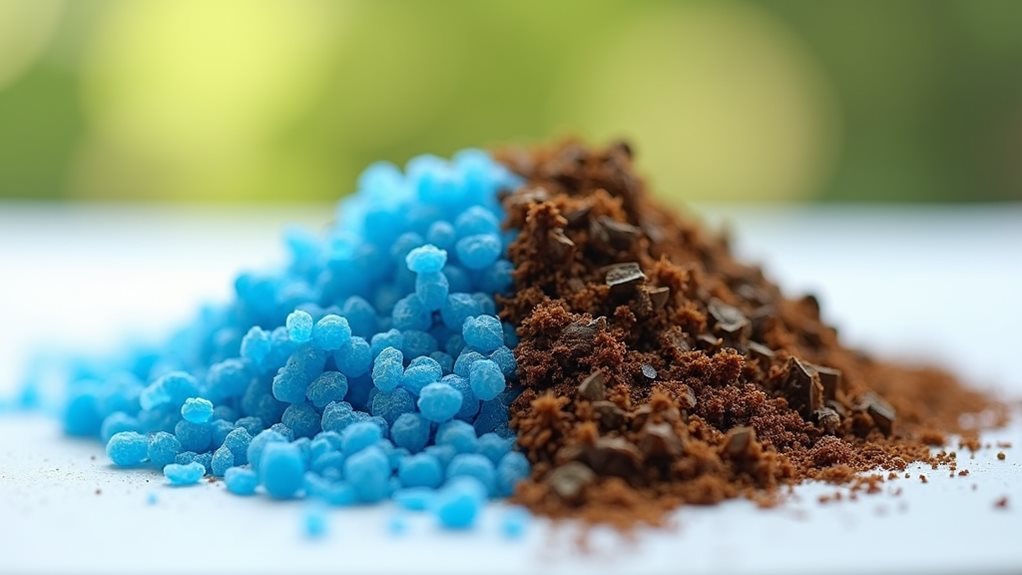
Over millions of years, plants have evolved to be remarkably self-sufficient organisms that produce their own food through photosynthesis.
They obtain carbon, hydrogen, and oxygen from air and water, while absorbing essential nutrients through their roots. Soil pH plays a critical role in nutrient availability, influencing how effectively plants can absorb these essential elements. You'll find that plants don't actually "eat" the fertilizer you provide – instead, they use these nutrients to support their self-made food production process. Some unique species like carnivorous plants have adapted to obtain additional nutrients by consuming insects and small prey in nutrient-deficient environments.
Understanding Natural Plant Food
Natural plant food takes many forms beyond commercial fertilizers you'll find at garden centers. You can create nutrient-rich solutions from organic materials like comfrey, stinging nettles, and banana peels, which provide essential macro and micronutrients for your plants. These homemade options are particularly beneficial for indoor plants that may struggle with limited nutrients. While the NPK ratios in these homemade options may vary, they'll support healthy root development and contribute to improved soil conditions. These natural solutions act as both sustainable fertilizers and mulch to prevent soil erosion while nourishing your garden.
Breaking Down Fertilizers

When you're examining fertilizer labels, you'll notice a series of three numbers (like 10-5-10) that represent the percentage of nitrogen, phosphorus, and potassium in the product. It's important to ensure that the nutrients in the fertilizer align with the specific needs of your plants, similar to how guinea pigs require specialized diets to meet their nutritional needs. You can choose between chemical fertilizers, which provide immediate nutrient availability, or organic options that build soil health while feeding plants more gradually. Organic fertilizers carrying an OMRI emblem indicate they meet USDA Organic Standards. The release rate of nutrients is another key consideration, as quick-release fertilizers provide an immediate enhancement while slow-release formulations feed your plants steadily over several months.
NPK Ratios Explained
Understanding NPK ratios on fertilizer labels can seem like decoding a secret formula, but it's actually quite straightforward.
The three numbers represent the percentage by weight of nitrogen (N), phosphorus (P), and potassium (K). For example, a 10-5-5 fertilizer contains 10% nitrogen, 5% phosphorus, and 5% potassium, with each nutrient serving distinct roles in plant growth and development. Different ratios like 1:1:1 ratio fertilizers provide equal amounts of each nutrient for balanced feeding.
Chemical Vs Organic Forms
How do chemical and organic fertilizers differ in their fundamental makeup and impact?
Chemical fertilizers are manufactured synthetically with specific NPK ratios but limited additional nutrients, while organic options come from natural sources like manure and compost, containing diverse micronutrients.
Chemical fertilizers require frequent reapplication and can damage soil structure, whereas organic alternatives improve soil health, release nutrients slowly, and promote beneficial microorganisms.
Slow Vs Quick Release
The choice between slow-release and quick-release fertilizers can considerably impact your garden's success.
Slow-release options gradually provide nutrients through coated granules, reducing the risk of over-fertilization and runoff. While they're initially more expensive, they'll save you time and money by requiring fewer applications.
Quick-release fertilizers offer immediate results but need frequent reapplication and carry higher risks of nutrient leaching.
The Photosynthesis Process
Life on Earth depends on photosynthesis, an impressive process where plants convert sunlight, water, and carbon dioxide into chemical energy and glucose.
During the light-dependent phase, plants split water molecules and produce ATP and NADPH, while releasing oxygen as a by-product.
These energy molecules then power the Calvin cycle, where carbon dioxide is changed into glucose for the plant's use.
Essential Plant Nutrients
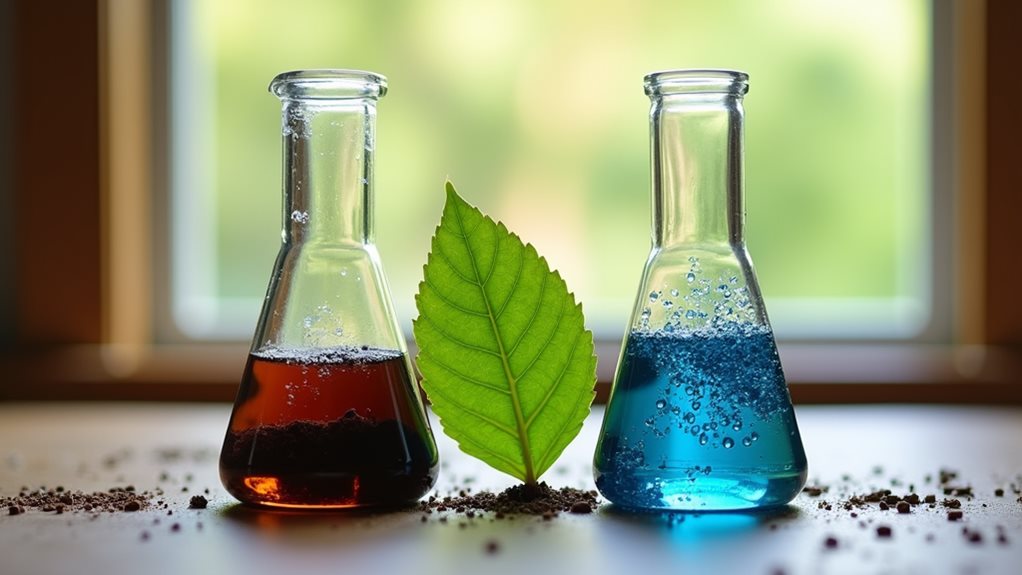
Plants require specific nutrients to thrive, much like humans need a balanced diet for ideal health. They need macronutrients like nitrogen, phosphorus, and potassium in larger quantities, while micronutrients such as iron, zinc, and manganese are required in smaller amounts. You'll find these nutrients in different forms, with nitrogen being absorbed as nitrate and ammonium ions. Additionally, proper soil preparation is crucial for ensuring that these nutrients are available to the plants.
Common Fertilizer Misconceptions
Marketing claims often lead you to believe that "plant food" and "fertilizer" are the same thing, though scientifically speaking, plants make their own food through photosynthesis.
You'll notice fertilizer labels use confusing terms and numbers that don't clearly explain what you're actually providing to your plants.
Understanding that fertilizers supply essential nutrients rather than "food" will help you make better-informed choices about your plants' nutritional needs and avoid common misconceptions about how plants actually use these materials.
Marketing Vs Scientific Reality
Understanding the difference between marketing terminology and scientific reality can help you make better-informed gardening decisions.
While many products are labeled as "plant food," they're actually fertilizers – supplements you add to provide nutrients like nitrogen, phosphorus, and potassium.
True plant food comes from photosynthesis, where plants convert water, air, and sunlight into the energy they need to grow.
Fertilizer Labels Cause Confusion
Fertilizer labels can be a significant source of confusion for both new and experienced gardeners.
You'll notice manufacturers use different NPK ratios for similar plant types, and there's no true "plant-specific" fertilizer despite marketing claims.
When you're examining labels, focus on the guaranteed analysis section showing nutrient percentages, rather than assuming higher numbers mean better results.
Nutrients Vs Plant Food
In spite of widespread marketing, the term "plant food" is frequently misused when referring to fertilizers.
Plants actually produce their own food through photosynthesis, using carbon, hydrogen, and oxygen from water and air.
What you're adding with fertilizers isn't food but rather essential nutrients like nitrogen, phosphorus, and potassium that enhance the soil and support healthy growth.
Organic Vs Synthetic Options
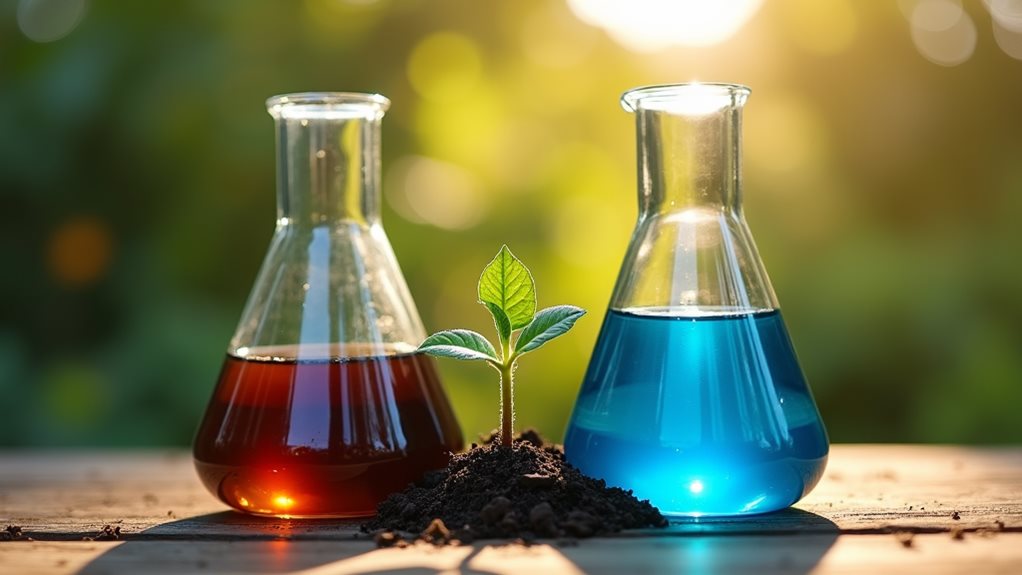
When choosing between organic and synthetic fertilizers, you'll find distinct advantages and trade-offs with each option.
Organic fertilizers release nutrients slowly while improving soil health through beneficial microorganisms and sustainable practices.
In contrast, synthetic fertilizers provide fast-acting nutrients but may risk over-application and soil depletion over time.
While synthetics offer quick results, they don't contribute to long-term soil improvement like organics do.
When to Use Fertilizers
The timing of fertilizer application plays an essential role in your plants' health and growth success.
You'll want to fertilize during active growth periods, particularly in early spring after the last frost when plants show new leaves and buds.
For indoor plants, apply liquid fertilizer monthly during growing seasons, but avoid feeding during winter months or when plants are stressed.
Signs of Nutrient Deficiency
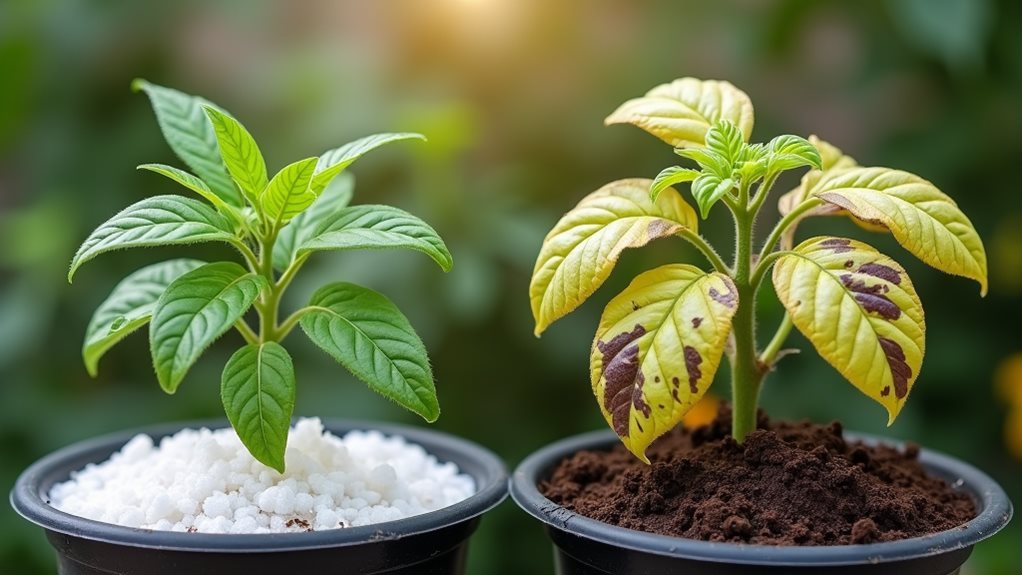
When your plants aren't thriving, they'll often show warning signs that can help you identify specific nutrient deficiencies.
Understanding these visual cues, such as yellowing leaves, stunted growth, or unusual discoloration, will enable you to quickly diagnose and address nutritional problems before they become severe.
You'll need to carefully examine both old and new growth, watching for telltale symptoms like leaf margin changes, spots between veins, or abnormal shoot development that point to specific nutrient shortages.
Common Deficiency Warning Signs
Identifying nutrient deficiencies in plants requires careful observation of specific warning signs.
You'll notice yellowing or pale-green leaves with nitrogen shortage, while phosphorus-deficient plants display purplish coloring and stunted growth.
Potassium deficiency reveals itself through leaf margin damage and increased disease susceptibility.
Look for tip burns with calcium issues, and interveinal yellowing often signals magnesium problems.
Diagnosing Plant Nutrient Problems
Through careful observation and systematic testing, diagnosing plant nutrient problems requires a multi-step approach to pinpoint exact deficiencies.
You'll need to examine symptom patterns across your plants, test soil and growing media's pH and EC levels, and rule out other potential causes.
It's essential to collect both soil and tissue samples for analysis, while consulting experts to interpret results accurately.
Environmental Impact of Fertilizers
Understanding the environmental impact of fertilizers reveals a complex web of concerns affecting our air, water, and soil.
When you use inorganic fertilizers, you're contributing to greenhouse gas emissions, particularly nitrous oxide, which is 300 times more potent than carbon dioxide.
The runoff from these fertilizers can contaminate groundwater and harm aquatic ecosystems, while their production processes lead to habitat destruction and soil degradation.
Best Fertilizing Practices
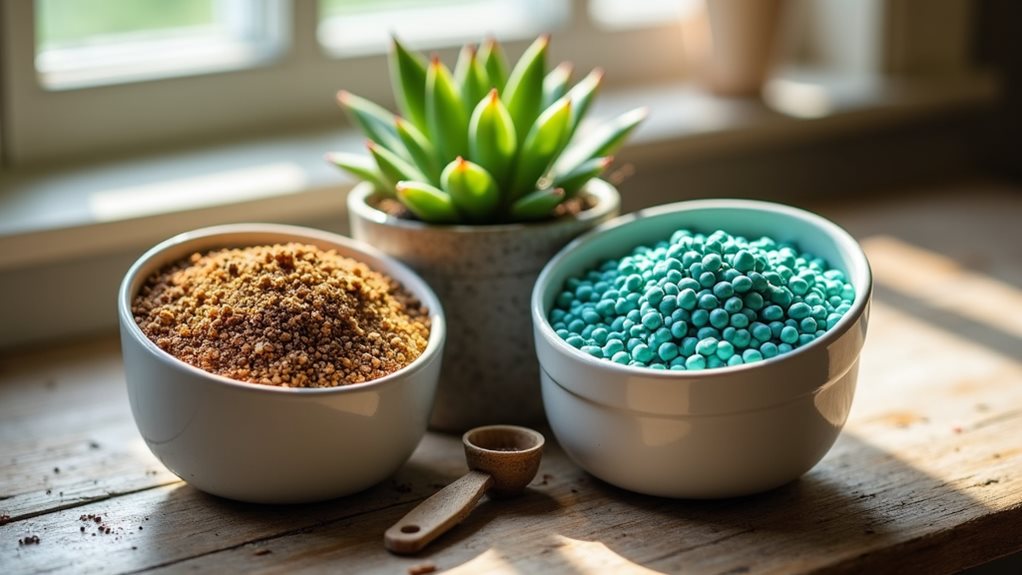
Successful fertilizing requires a strategic blend of timing, technique, and product selection.
You'll want to test your soil first to identify nutrient needs, then calibrate your spreader for precise application.
When applying granular fertilizers, incorporate them into the top 6-8 inches of soil, and for existing plants, sprinkle around the drip line.
Don't forget to dilute liquid fertilizers properly.
Sustainable Garden Nutrition
Nourishing your garden sustainably starts with working alongside nature rather than against it.
You'll find success by implementing crop rotation, composting organic matter, and utilizing free nutrient sources like diluted urine and weed material.
Support your soil's ecosystem by adding beneficial microbes through composting, protecting soil structure, and maintaining diverse plantings to reduce pest problems naturally.
And Finally
While plant food and fertilizers share some common ground, you'll find they serve distinct roles in plant nutrition. Understanding the difference helps you make informed choices for your garden's health. By following sustainable practices, properly timing fertilizer applications, and working with nature's processes, you're supporting both your plants and the environment. Remember, successful plant care combines knowledge of natural nutrition with strategic use of supplemental fertilizers when needed.